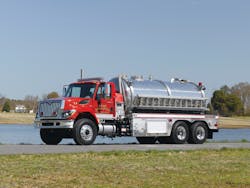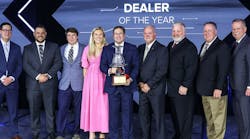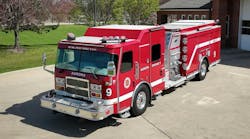E-ONE designs, manufactures and markets fire-rescue apparatus worldwide, including custom and commercial pumpers, tankers, vacuum tankers, aerial ladders and platforms, command and communication apparatus, quick-attack units, industrial trucks and aircraft rescue and firefighting (ARFF) vehicles. The company was founded in 1974 and is headquartered in Ocala, FL. I sat down with Jay Johnson, vice president of sales and product management at E-ONE, to discuss the latest in fire apparatus development for the small-community fire department.
Rural Firefighting Academy (RFA): What’s E-ONE’s overall strategy for serving the small-community fire department?
E-ONE: As you know, rural small-community fire departments across North America cover a diverse range of fire protection requirements, from large fire districts that may include several small communities, to a single small town. Geography and terrain can vary, so E-ONE offers a variety of pumper and tanker products to meet various operational requirements.
One common hazard many rural communities face is wildland or brush fires. For this application, we have developed a unique pump-and-roll option that utilizes a hydraulic-driven fire pump and in-cab controls. This system features a variable displacement hydraulic pump to maintain constant pressure regardless of engine or vehicle speed – whether stationary, moving forward or reverse. An in-cab control system engages the hydraulic system, opens the tank valve and brings the pump up to speed with a single switch. A movable joystick allows the driver or officer easy access to control the bumper turret and ground sweep nozzles. This system can be used with a variety of pumper and tanker products.
RFA: Rural fire departments often work within a limited budget and look to stretch purchase dollars. What do you have for those departments that want performance features and value?
E-ONE: We have several pumper and tanker products configured to be simple, reliable and cost-effective, either on commercial or custom chassis, without compromising performance or quality. Standard body construction features our exceptional four-sided seamless aluminum extrusions interlocked and welded to 3/16ths-inch aluminum plating.
Additionally, for those fire departments that prefer stainless-steel construction, we have the flexibility to offer a 100% stainless-steel body structure and sub-frame. Beyond the base truck models, the option sets have been carefully selected to provide features and accessories that rural fire departments need at an affordable price.
RFA: The capacity to effectively draft from static and dynamic water sources, and then move the water using tankers, is a hallmark of the rural fire service. Tell us a little about what E-ONE has done in the area of improving rural water movement efficiency.
E-ONE: From a tanker application perspective, our Water Master vacuum apparatus was developed by a rural fire chief as a result of his search for the most effective method to secure and transport a water supply to the rural fire scene.
It is well documented that three primary factors in tanker water supply delivery are travel time, fill time and dump time. Trying to deliver more gallons per minute with a tanker by driving faster is futile and adds potential risk associated with higher road speeds. Driving a distance of two miles at 55 mph versus 35 mph would save about one minute and yield about 20 gpm. The most effective way to deliver more water with a tanker is to spend less time at the fill and dump sites – this is where our Water Master really shines.
At the fill site, the Water Master uses a large PTO-driven vacuum pump to create a vacuum within the tank. By using vacuum, it self-fills at high rates. This means that pumpers and portable pumps are not required at the fill site, both reducing cost and time required to deliver water to the fire scene. The Water Master unloads into a portable folding tank at a high and consistent gpm rate. Because the tank is pressurized during unloading, the last gallon of water in the tank is virtually discharged as quickly as the first gallon.
Important to note, the National Fire Protection Association, in its NFPA 1901, Standard for Automotive Fire Apparatus, 1999 edition, recognizes the use of pneumatic systems to pressure unload and vacuum fill tankers. The vacuum system provides power for complete filling and dumping. No water is spilled during transit because the tank is sealed. More water is delivered to the fire scene and roads are not splashed with water, which could potentially create less than favorable driving conditions during sub-freezing weather.
Interestingly, because of the capability to completely fill, dump and feature no water spillage, in some regions, ISO exempts the vacuum apparatus from the usual 10% deduction in the water-supply formula.
RFA: What are the actual results rural departments have found with using the Water Master vacuum tanker?
E-ONE: Actual ISO water shuttle tests have shown that one 3,500-gallon Water Master can maintain a 250-gpm flow rate with a three-mile roundtrip distance.
For example, one fire department in Lamar County, MS, performed a 1,500-gpm water shuttle test using six Water Masters from within their automatic aid group. The roundtrip travel distance was two miles and 1,500 gpm was sustained for one hour. Two portable monitors were used, one flowing 500 gpm and the other flowing 1,000 gpm. The chief reported that the shuttle went smoothly. Participants were impressed by the volume of water delivered by using a minimum contingent of personnel and equipment.
RFA: What features have you designed into the Water Master to make it operator friendly or easy to use?
E-ONE: Every Water Master has two cameras, one rear facing and one on the officer side of the tank. The side discharges are placed right behind the cab so that the driver can easily maneuver into the fill or dump site. All of the Water Master controls are easy to use and can be operated from the driver’s seat. All three intake/discharge valves also have outside controls located near the valve. And the Water Master vacuum water loading system can work with high lifts – up to 28 feet – to make more surface water sites usable for fire protection.






